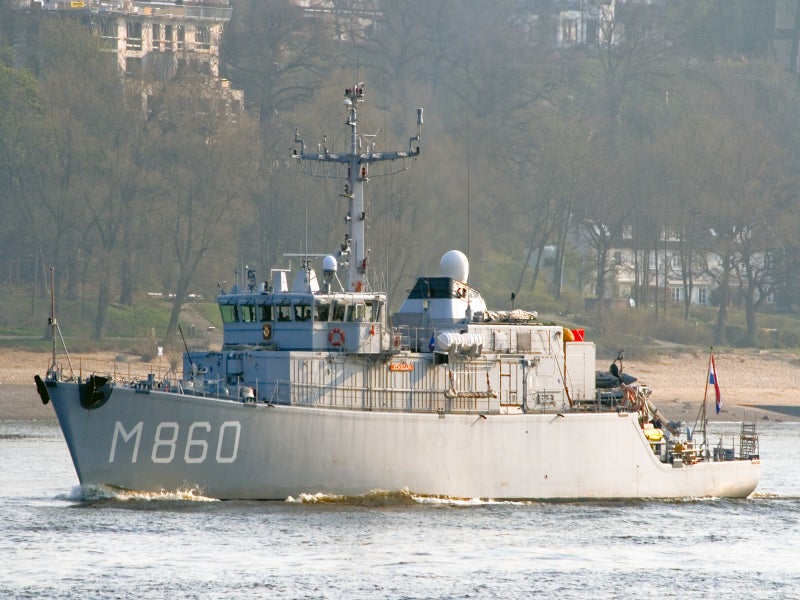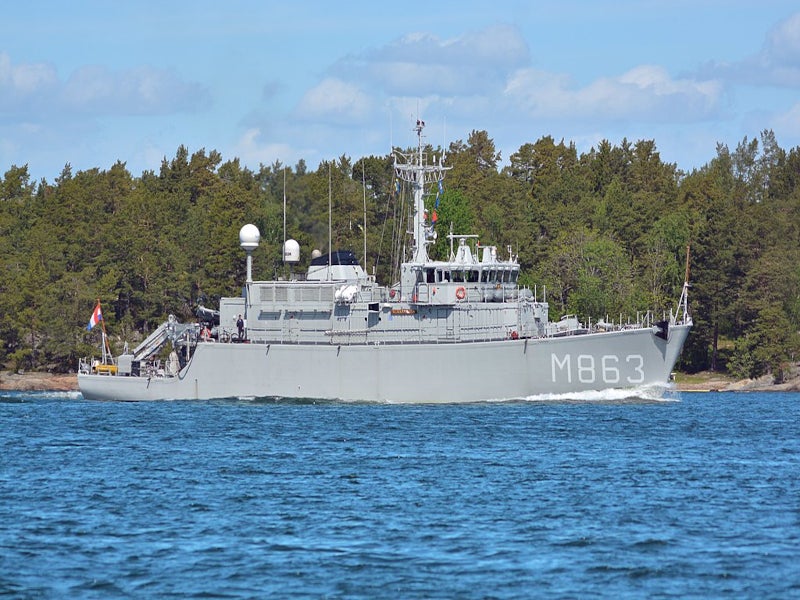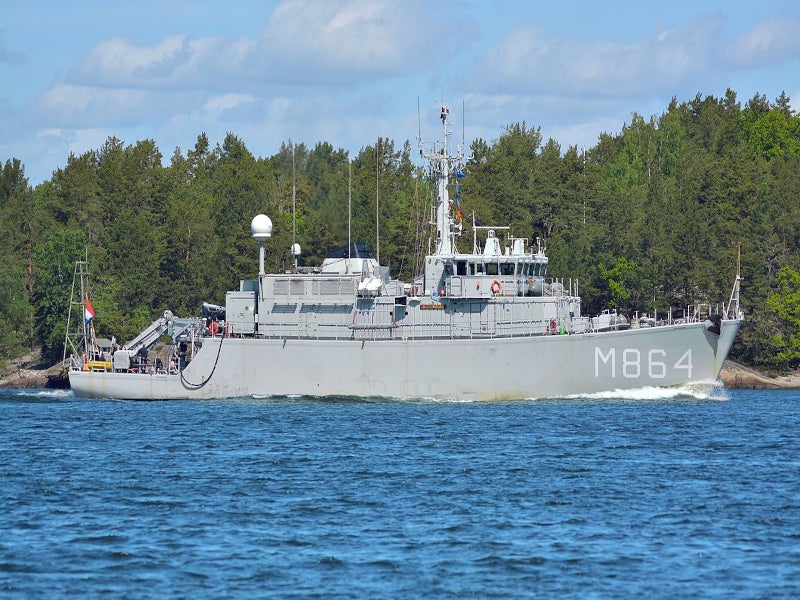The Alkmaar-class mine countermeasures vessels were built at the Van der Giessen-de Noord shipyard in Alblasserdam, the Netherlands, for the Royal Netherlands Navy.
A total of 15 Alkmaar-class vessels were built, of which five are currently in operation with the Dutch Navy, namely Makkum (M857), Schiedam (M860), Zierikzee (M862), Vlaardingen (M863), and Willemstad (M864). The remaining vessels were decommissioned.
The vessels are used to keep the sea, coastal waters, and approaches to harbours free of mines and support naval units during mine clearance operations around the world. They are also deployed for historical ordnance disposal, coastguard duties, hydrographical tasks, and sea-diving missions.
The Netherlands is procuring six new mine countermeasures vessels under a bilateral project with Belgium to replace the Alkmaar-class vessels. The launch of Vlissingen, the first Dutch vessel under the project, is expected by the end of September 2023.
Alkmaar-class vessels development and operations details
The Alkmaar-class vessels were built between 1980 and 1987 as part of a joint project with France and Belgium.
Alkmaar is the Dutch designation for the Tripartite class developed under the project.
Makkum entered service with the Royal Netherlands Navy in May 1985. Schiedam joined the fleet in July 1986, while Zierikzee, Vlaardingent, and Willemstad were commissioned in May 1987, March 1989 and September 1989, respectively.
The Alkmaar-class vessels were modernised between 2005 and 2010 with advanced sensors, weapons and command system.
As part of the Standing Nato Mine Counter Measures Group 1 (SNMCMG1), Schiedam participated in the Norway-led multinational exercise Cold Response in April 2022.
Foreign sales and donations
Most of the decommissioned Alkmaar-class mine-hunting ships were sold to Pakistan, Latvia, and Bulgaria.
Greece signed a letter of intent with the Netherlands to obtain six Alkmaar-class mine countermeasures vessels for the Hellenic Navy in October 2021.
The Netherlands Minister of Defence will provide two Alkmaar-class vessels to Ukraine starting in 2025 once the vessels are replaced by the new mine countermeasures vessels in the Royal Netherlands Navy. The vessels will mainly support the Ukrainian Navy in mine-clearing operations in the Black Sea.
Design and features of the Alkmaar-class vessels
The Alkmaar-class vessels measure 51.5m long and 8.9m wide and have a draught of 3.8m. The vessels displace more than 543t of water and can accommodate between 28 and 38 crew members. They are equipped with an inertial navigation system.
The hull of the vessel was built with polyester while the superstructure was made of aluminium. Steel wasn’t used in the vessels.
The ships have been modernised to include a new galley, fire alarm, and firefighting installation. An uncrewed technical central (TC) eliminates the need for a technician in the TC. Error messages are transmitted to the technician’s telephone.
Command and control of the mine-hunting vessels
The mine-hunting vessels are equipped with Atlas Elektronik’s integrated mine countermeasure system to detect and clear explosives.
The vessels are operated from the bridge, command centre/mine-hunting centre and radio hut areas. The bridge allows operations of all installations from a single panel with minimal occupation.
The command centre and radio hut are positioned near the bridge. During the mine-hunting operation, the command centre assumes control of the vessel completely while the bridge performs the safety operations for navigation.
Sonar system
The hull is mounted with the Thales Underwater Systems’ (TUS) TSM 2022 MkIII sonar for improved mine-hunting efficiency with simultaneous detection and classification of underwater objects in adverse environmental conditions.
The sensor package can also include a self-propelled variable depths sonar (SPVDS) in scenarios where the performance of the hull-mounted sonar (HMS) is ineffective.
The SPVDS used is the Saab Bofors Double Eagle MkIII mini-submarine with the TSM Mk 2022 sonar.
The SPVDS is controlled by the mine-hunting centre and can manoeuvre in the water in front or deep underneath the vessel. The cable between the vessel and the SPVDS is operated by the cable protection unit.
The position of underwater vehicles such as SPVDS is determined by the acoustic positioning system (APS).
Mine-hunting mechanism of the HMS vehicles
The sonar equipment enables the mine-hunting vessels to detect mines, shipwrecks, and missing containers.
The HMS vessels can detect most underwater objects but are sometimes ineffective due to temperature differences and salinity.
In such cases, the SVPDS vehicle provides an ideal solution as it can detect objects even in areas with greater water depths and different water layers.
Once a mine is identified, Atlas Elektronik’s SeaFox uncrewed underwater vehicle is deployed into the water to either inspect or destroy the mine. The wire-guided system reaches the mine with the help of APS. Alternatively, divers can be engaged to dispose of the mine by attaching an explosive to it.
Detection and classification range
The vessel can detect bottom-laid and moored mines at water depths ranging between 10m and 80m. Under normal conditions, its detection range varies between 400m and 1,000m, and its classification range is between 100m and 170m.
Weapon system aboard
The vessels are equipped with three M2 heavy machine guns, and SeaFox, which is a mine identification and destruction system.
Types of Sea Fox onboard the minehunter
Depending on the mission requirements, the ship uses different types of SeaFox.
Sea Fox T (Training) is designed to support training requirements of deck crew and minehunting centre personnel.
The Sea Fox I (Investigate) version is used to find and investigate the target. It comes with a sonar and a camera.
These two variants can be retrieved once their task is completed.
The combat variant, black Sea Fox C, has sonar and is a fire-and-forget weapon system fitted with an explosive to clear the target. It detonates after coming into contact with the mine, and thus cannot be retrieved.
Accommodation details
The vessel offers good living conditions to the crew members, in compliance with the Hazard Analysis and Critical Control Point (HACCP) guidelines. It features active stabilisation, permanent nuclear, biological and chemical (NBC) protection throughout the ship, air conditioning, a freezer room, potable water production facilities, and laundry.
Diving installations onboard the minehunters include a decompression tank that can accommodate only one person. The decompression tank can be lifted by helicopter for the safe transport of a victim to a hospital.
Engine and propulsion system of the mine countermeasures vessels
The vessels are powered by two propulsion systems, the main diesel (D) system and the auxiliary electric (E) system. The D-system consists of a Stork Werkspoor type RUB215V12 engine delivering 1,370kW at 1,200rpm.
The engine drives a variable and reversible-pitch propeller through an epicyclic reduction gearbox.
The E-system comprises two ACEC active rudders. Each rudder is fitted with a fixed-pitch nozzle propeller that is driven by an 88kW electric motor.
Three gas-turbine-powered alternator sets are installed to provide electric current for the motors.
The vessel features a twin-screw propulsion arrangement together with two Schottel bow thrusters to accurately hover over a sonar contact in rough sea conditions. The vessel can sail at a maximum speed of 15 knots.










